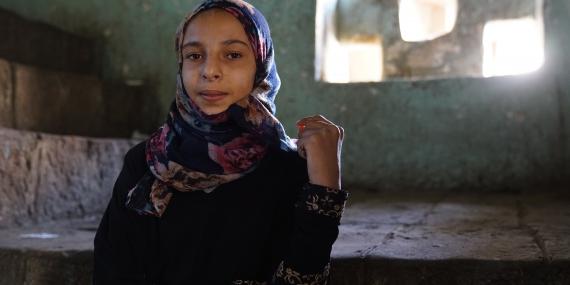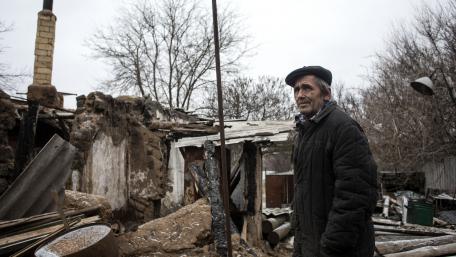Ibb, Yemen
This 13-year-old girl is a former Taizz resident. She and her family fled the fighting in 2015. Now she wants to be an architect and design modern buildings. OCHA/Giles Clarke
Conflict and hostilities combined with economic contraction and governance challenges continue to devastate communities and increase humanitarian and protection needs in the Middle East and North Africa region.
Over 12 million people are internally displaced across the region, with some displaced multiple times facing protection risks and human rights violations, including gender-based violence, which is particularly affecting women and girls. Protracted and escalating hostilities in parts of Syria, Yemen and Libya continue to force people to flee their homes and communities and exacerbate civilian suffering, deaths and injuries.
The economic crisis, including soaring inflation and fuel shortages in several countries, exacerbates an already fragile food security and nutrition situation and erodes people’s coping capacities. Many are resorting to negative coping mechanisms such as skipping meals, increasing debt and child marriages to meet basic needs.
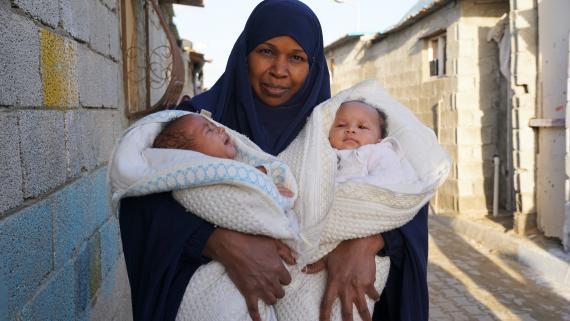
Benghazi, Libya
A mother holds her 2-month-old twins in an IDP settlement in Benghazi. She and most of her neighbours fled the now-destroyed town of Tawergha, some 600 km west of Benghazi. The town was devastated in some of the heaviest fighting of the Libyan conflict between 2011 and 2015. Her husband and eight of her nine children live in a two-room shelter with a corrugated metal roof. Winter is the most difficult time. She said: “It is very difficult to keep the children warm and to find proper treatment and medicine whenever they get sick.” However, despite the situation, she is grateful that her children are currently safe and healthy. “My children’s well-being is the most important thing, so I thank God every day for that.”
OCHA/Giles ClarkeIn Syria, despite relative stability in the third quarter, food prices remain 90 per cent higher than in the first half of 2020, while the fuel crisis and currency depreciation in Yemen continue to increase prices of essential commodities, affecting critical services and aid operations. The Beirut Port explosions multiplied Lebanon’s worst economic crisis in its recent history. The Lebanese pound continues to depreciate, unemployment is rising, prices of basic goods are surging rapidly, and the threat of hunger is looming for the poorest people. Acute malnutrition remains a major characteristic, with increasing numbers of acutely malnourished children and women reported in multiple countries. This includes parts of Yemen, where cases of young children suffering from severe acute malnutrition have increased by 15 per cent.
Middle East and North Africa: Overview of appeals
COVID-19 has had a devasting impact on people, stretched health systems and other basic services and intensified already high humanitarian needs. Years of active conflict in the region have decimated basic infrastructure. This combination of factors along with the economic downturn has left countries in the Middle East and North Africa struggling to keep up with the pace of the pandemic, including absorbing confirmed cases in health facilities or maintaining other essential health services such as routine vaccinations. Even worse is the pandemic’s socioeconomic impact; it has eroded livelihoods, reduced remittances, increased unemployment and pushed vulnerable people further into poverty.
Millions of people rely on humanitarian assistance for their basic needs, including through cross-border operations. However, partners continue to face access challenges reaching affected communities due to conflict, insecurity, blockades and bureaucratic impediments; the COVID-19-related containment measures have further constrained this access – as infection rates surge, more movement restrictions are expected.
Evolution of People in Need (2020 vs. 2021)
In the coming year, the challenges remain immense. Over 45 million people across the region will need some form of assistance. If left unaddressed, conflict and violence, political and economic instability and food insecurity will continue to drive up humanitarian and protection needs across the region.
Further reading
Source: OCHA
Iraq
Analysis of the context, crisis and needs
Of the 6 million people displaced during the conflict with ISIL, 1.3 million people remain internally displaced with limited prospects of durable solutions. Many of the 4.7 million returnees still experience acute humanitarian needs, jeopardizing sustainable returns. The impact of COVID-19, particularly the loss of livelihoods, disrupted access to services and increased protection risks (including GBV), has increased humanitarian needs among conflict-affected populations, particularly in out-of-camp and return locations.
Protracted displacement continued in 2020. Ninety-two per cent of IDPs have been displaced for more than three years, with under 1 per cent of IDPs returning per month on average. Four out of five IDPs live in out-of-camp settings. The main obstacles to return remain damaged or destroyed houses, and a lack of livelihoods and basic services in areas of origin. Insecurity in areas of origin also remains a key challenge to return.
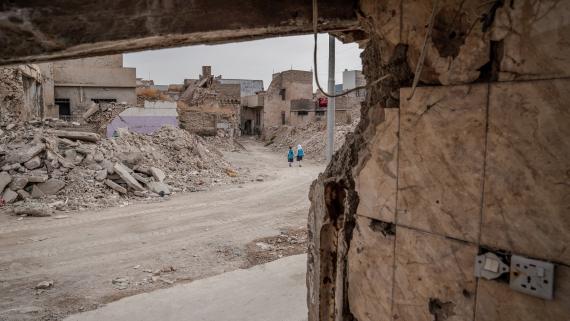
Mosul, Iraq
Two girls go to school amid the destruction from the last war, west of Mosul. Three years after Mosul was retaken from the so-called Islamic State, parts of west Mosul still resemble a warzone, with entire neighbourhoods destroyed. Buildings remain collapsed into each other like a deck of cards. They create a dangerous mess of bricks and steel that looms over children and families trying to resume their lives as best they can, despite daily reminders of the violence.
UNICEF/AnmarOptions for durable solutions remain limited. Progress on improving conditions in return areas at the beginning of the year was reversed by the impact of COVID-19. This complicated efforts to ensure durable solutions to displacement and jeopardized sustainable returns. Government-led camp closures since October 2020 could push in-camp IDPs into areas with limited options for a safe and dignified life.
Humanitarian needs have become more acute. COVID-19 exacerbated pre-existing vulnerabilities among conflict-affected populations, resulting in increased use of negative coping mechanisms. In-camp IDPs have become increasingly aid dependent as livelihoods were lost due to COVID-19. Acute needs have also increased in out-of-camp settings, with the percentage of out-of-camp IDPs in acute need increasing from 36 per cent to 45 per cent over the past year. Thirty-eight per cent of returnees now face acute needs, compared to 28 per cent last year. In the absence of durable, safe and dignified solutions to displacement, and due to the compounding effects of COVID-19, 4.1 million IDPs and returnees need humanitarian assistance, with more than half (2.4 million people) facing acute need.
Projected situation in 2021 and beyond
The situation in Iraq is extremely volatile due to COVID-19 and the political and security context. The humanitarian community plans for a flexible humanitarian response, adapting to the changing circumstances throughout the year.
The closure of IDP camps has been a goal of successive Iraqi administrations. In October 2020, the Government started closing several IDP camps, with more expected to close in the coming months. Based on previous experience, sudden and premature camp closures result in substantial secondary displacement, with about one third of camp departures resulting in returns unlikely to be sustainable.
Evolution of needs and requirements (2016 - 2021)
COVID-19 will continue to impact the situation in the country. Iraq’s economy is projected to contract by 9.3 per cent in 2020 and poverty rates are expected to increase. Millions of people could end up using negative coping mechanisms to meet basic needs. The provision of essential health services is under pressure, and families are not accessing essential services, including immunizations and mother-and-child health care, to the same extent as in 2019. An estimated 300,000 children risk missing vaccinations, which could lead to measles outbreaks or the return of polio (eradicated in 2014).
The impact of COVID-19 hits conflict-affected populations particularly hard, but it also affects the general population. In the absence of at-scale social safety nets, more people could fall under the emergency threshold. The humanitarian community will closely monitor vulnerability levels throughout the country and take appropriate action should emergency thresholds be crossed.
Response priorities in 2021
The 2020 Iraq HRP targeted 1.8 million people. It is projected to reach 1.4 million people by the year’s end despite significant movement and access challenges. The HRP was adjusted in early 2020 to mitigate and respond to the impact of COVID-19 and to adapt implementation to the new operating environment.
The 2021 Iraq HRP will target 2.5 million people, including all IDPs in camps, out-of-camp IDPs in acute need and returnees in acute need, paying attention to age, gender and disability. The targeting criteria thus remain as in 2020. While all in-camp IDPs were reached with assistance in 2020, challenges remained to reach all IDPs out of camp and returnees (projected reach of 71 per cent and 61 per cent, respectively). With ongoing Government-led camp closures, more people are expected to move to out-of-camp settings and the response will have to adjust to address acute needs in these new locations.
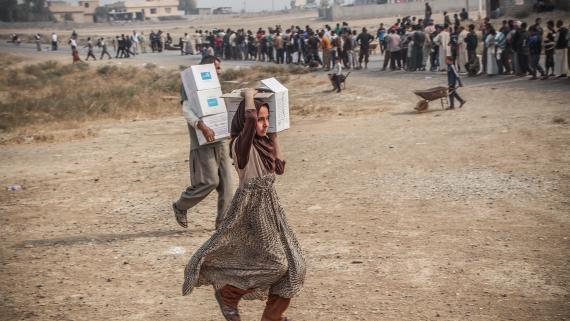
Ibrahim Al Khalil, Iraq
Humanitarian partners distribute emergency assistance consisting of water, hygiene items and ready-to-eat food in Ibrahim Al Khalil village. Aid workers strive to assist displaced people as soon as humanitarian access is possible.
OCHA/Themba LindenDue to the increased number of people facing acute humanitarian needs, the 2021 Iraq HRP will have a decidedly humanitarian focus to alleviate suffering, and to enable the most vulnerable populations to meet basic needs, minimize the use of negative coping mechanisms, access essential services, and live-in safety and dignity.
The humanitarian community will work closely with the Durable Solutions Task Force, which will promote sustainable returns and durable solutions for conflict-affected populations and improve conditions in return areas, and with development partners and the Iraqi Government to address longer-term needs.
Further reading
Source: Humanitarian Insight
Source: Financial Tracking Service
Source: OCHA
Libya
Analysis of the context, crisis and needs
Libya is struggling to cope with the effects of ongoing armed conflict, economic and governance crises, and the direct and indirect impact of COVID-19, all of which have resulted in the deterioration of public services and people’s livelihoods. The crisis in Libya has a strong protection dimension, with violations of international human rights and humanitarian law, including conflict-related sexual violence and grave violations against children.
Due to the armed conflict that extended into 2020, 417 civilian casualties were reported as of June. Indiscriminate shelling has also damaged and destroyed health facilities, schools, water infrastructure, and people’s homes. Between January and September, Libya recorded 28 attacks on medical facilities, ambulances, and medical personnel, resulting in the deaths of eight people and injury of 23 others. Armed conflict and insecurity continued to drive displacement during the first part of the year. A rapid shift of the frontlines in June and July allowed a few thousand people to return home although the destruction of basic services and the presence of explosive hazards remain major constraints that are hindering safe and dignified returns. As of September, 392,000 people remained internally displaced throughout the country.

Benghazi, Libya
The Qaryounis settlement in Benghazi is home to 204 families (677 individuals), almost all of whom were displaced from Tawergha in 2011. Most of the shelters have corrugated metal or zinc roofs that need maintenance. In the rainy season, the families experience leaks in the shelters. The rainy season also causes problems with the sewage system and waste overflows, since almost all the families rely on unprotected septic tanks to manage the waste. Accessing safe drinking water is another major concern. Even though the settlement is equipped with a water network, unclean water flows in the network, so it can only be used for domestic purposes. Most of the families drink mineral water, posing a financial burden due to its relatively high price.
OCHA/Giles ClarkeLibya continues to be at high risk of the spread of COVID-19. A serious obstacle to responding to the COVID-19 pandemic has been the fragmented governance in Libya. By September, a national preparedness and response plan for COVID-19 was still to be endorsed. The true scale of the pandemic is likely still not known due to shortages in COVID-19 testing supplies, adequate health care facilities and contact tracing.
The ability of many people to cover basic needs, including housing, has been eroded by the current economic crisis and the socioeconomic impact of COVID-19. During 2020, the country regularly experienced prolonged power and water cuts, as well as fuel shortages, further affecting people’s livelihoods and disrupting critical services. Movement restrictions imposed to reduce the spread of the virus have driven up the price of essential food and goods by 20 per cent above pre-COVID levels as of September 2020, and negatively affected people’s livelihood opportunities. Unemployment in vulnerable groups have increased with about 27 per cent of surveyed migrant workers unemployed in August, compared to 10 per cent in February. Many women who rely on the informal economy for their livelihoods have been similarly affected. Many migrants and refugees, including children, continued to face arbitrary detention, gender-based violence, forced labour, extortion, and exploitation.
Projected situation in 2021 and beyond
About 1.3 million people are estimated to need some form of humanitarian assistance next year, a 40 per cent increase compared to 2020. The highest needs are found in Alkufra, Benghazi, Ejdabia, and Tripoli due to the impact of armed conflict. These locations also host the highest number of displaced, migrant, and refugee populations. The formal ceasefire agreement signed on 23 October, while still to be implemented, holds promise. Should the ceasefire be accompanied by associated, positive political and economic developments, internal displacement would reduce as households may feel secure enough to return home. Access to services would likely improve as increased revenue, specifically from the oil sector, would allow for more investment in public service delivery. However, these possible improvements could still be hampered in the foreseeable future by the continued impact of COVID-19 cases and imposed prevention measures to curb the spread of the disease.
Evolution of needs and requirements (2016 - 2021)
Even with an optimistic upturn in Libya’s fortunes, humanitarian needs will remain high in the near term as agreements materialize on the ground and the economy rebounds. In the long term, it is anticipated that some vulnerable groups would still require some form of humanitarian assistance until sustainable solutions are achieved. Advocacy would also remain necessary in order to overcome the cultural barriers and discrimination.
Response priorities in 2021
IDPs, returnees, migrants, refugees and non-displaced people who are affected by Libya’s overall context will remain as priority vulnerable groups for the 2021 HRP. A total of 1.3 million people need humanitarian assistance and/or critical protection services. Of those, 451,000 of the most vulnerable people will be targeted by the 2021 HRP. The international humanitarian community will continue to work with Libyan stakeholders to cultivate the capacity of Libyan authorities to lead and implement protection and assistance for those most in need.
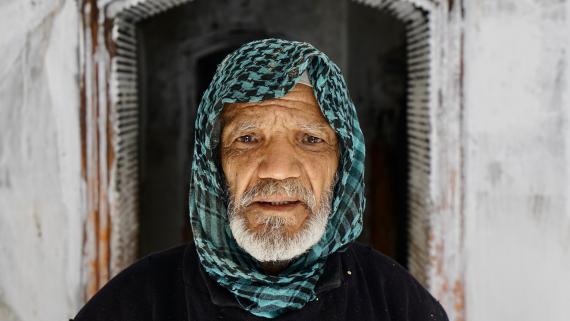
Awenia, Libya
This 70-year-old Libyan man was born and spent his life in Awenia. He and his family were displaced in 2011 after heavy armed conflict between pro- and anti-Gaddafi supporters, which destroyed his village. His wife and three daughters moved to Tripoli, but as the economic situation hardened, he was forced to move back to his home in the mountains. He and his wife currently live in a building without water or electricity, and they survive mostly on local donations. Three elderly women died in the village recently from the cold.
OCHA/Giles ClarkeCentrality of protection, age, gender and diversity, as well as capacity strengthening, will remain at the core of the humanitarian response. Safeguarding measures to prevent and provide protection from sexual exploitation and abuse will be strengthened. Data management will also be a key component of the response to ensure needs analysis and response planning are people-centered.
The financial requirement for the HRP 2021 is $189 million. The plan will complement Libyan efforts, with an emphasis on increasing coordination and collaboration in a principled manner.
Further reading
Source: Humanitarian Insight
Source: OCHA
Source: Financial Tracking Service
occupied Palestinian territory
Analysis of the context, crisis and needs
A protracted protection crisis continues in oPt, largely attributable to the ongoing occupation, the internal Palestinian divide, continued violations of international law, and recurrent escalations of hostilities between Israel and Palestinian armed groups. 2020 witnessed a sharp increase in the severity of humanitarian needs across oPt. This was due to the COVID-19 outbreak and measures taken by the Palestinian Authority (PA) in response to Israel’s threat to formally annex parts of the West Bank. These factors will continue to drive vulnerability and humanitarian need in oPt in 2021.
The COVID-19 mortality rate remains low by global standards (77 persons per million people). However, measures imposed to contain the pandemic (recurrent lockdowns, travel restrictions, school closures, reduction of commercial activities and mandatory quarantines) have severely undermined living conditions across oPt. In Gaza, unemployment in the second quarter of 2020 reached a historical high of over 49 per cent.
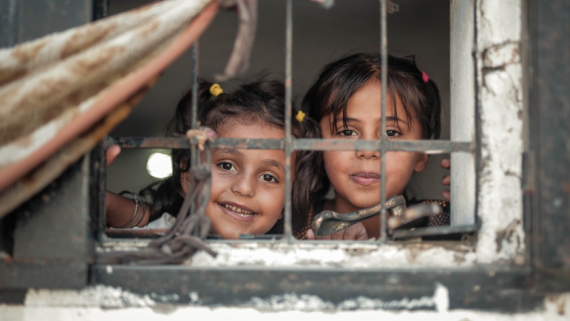
Jabalia, occupied Palestinian territory
Two siblings look out from inside their home. They are at risk of eviction from their rented home in Jabalia, Gaza.
Compounding the situation was the PA’s decision to halt almost all bilateral contacts with Israel, between May and November, including refusing to accept the tax clearance revenues that Israel collects on its behalf. Together with the economic slowdown due to the pandemic, this severely reduced the PA’s capacity to pay salaries, deliver services and maintain social safety nets. While, by mid-November 2020, the PA had indicated that it would resume coordination with Israel, the impacts are yet to be assessed and damage sustained from the six-month halt remains. UNRWA’s financial crisis also remains an element of concern with the potential for considerable humanitarian consequences across oPt.
There has been a significant decline in conflict-related casualties in 2020. However, concerns about excessive use of force by Israeli soldiers resulting in the killing or serious injury of Palestinians remain, as well as a lack of accountability for violations of international law. Significant shortfalls in funding for humanitarian organizations alongside an ever-increasing constriction of operational space are increasingly undermining the humanitarian community’s ability to respond to growing needs.
Projected situation in 2021 and beyond
The Palestinian economy is expected to shrink between 2.6 and 7.6 per cent by the year’s end, compared to 2019. The proportion of poor households in the Gaza Strip is projected to increase from 53 to 64 per cent and more than double in the West Bank, from 14 to 30 per cent. Against the backdrop of a general deterioration in living conditions and the lack of security coordination between the PA and Israel, the potential remains for an increase in violence, including an escalation of hostilities in Gaza, during 2021.
In the Gaza Strip, the 2 million Palestinians, who have been under Israeli blockade for over 13 years, have been further isolated from the external world by COVID-19-related restrictions and the halt in coordination, with serious impacts on access to medical care. At the same time, the main factors driving the fragile humanitarian situation there remain in place, with no changes foreseen.
Evolution of needs and requirements (2016 - 2021) (Copy)
In the West Bank, policies and practices affecting Area C, East Jerusalem and the Israeli-controlled part of Hebron city are expected to continue, placing Palestinians at risk of forcible transfer and leading to erosion of livelihoods. Economic development will remain hampered by the occupation and limitations on Palestinian access to land and natural resources, and by a multilayered system of administrative, bureaucratic and physical constraints, including the Barrier. Many of these constraints are linked to the presence of Israeli settlements, which are illegal under international law.
Throughout oPt, the most vulnerable people remain those living in poor or women-headed households; Palestine refugees living in refugee camps; children, particularly those under 5 years of age; the older population; pregnant and lactating women; persons with disabilities; small-scale farmers, herders and fishers; and displaced people.
Response priorities in 2021
In 2020, humanitarian partners aimed to reach 1.5 million Palestinians with assistance through the HRP. However, due to the COVID-19 outbreak in oPt, by April most of the regular HRP activities had been reprogrammed to respond to pandemic-generated needs. Overall, 1.2 million Palestinians received humanitarian assistance in 2020, including 300,000 people targeted by the original plan.
Key achievements included the allocation and mobilization of resources. This covered 94 per cent of the funds requested for the plan, meeting basic WASH needs for the most vulnerable people during the COVID-19 crisis. The oPt Humanitarian Fund provided rapid and flexible support to humanitarian operations to respond to the COVID-19 outbreak in oPt.
oPt: Adapting responses with flexible funding

The Humanitarian Coordinator (HC) used the oPt Humanitarian Fund to rapidly scale up response to the COVID-19 outbreak. In support of the Health Cluster Strategic Preparedness and Response Plan, the HC initially allocated $1 million to WHO to rapidly procure critical health supplies essential to expand testing, tracing, prevention and treatment for COVID-19 cases. The first standard allocation from the fund tackled the outbreak and mitigated the effects of the pandemic, in the framework of the Inter-Agency COVID-19 Response Plan. Several projects have been subsequently topped up to sustain operations in quarantine centres in the West Bank and Gaza. More than $16 million has been allocated to strengthen the health components of the response and ensure the delivery of critical COVID-19-related activities across the different sectors. Timely and rapid allocations from the fund boosted the procurement of screening tests, personal protection equipment, hygiene kits, consumables and other critical supplies, provided essential non-food items and water in quarantine centres, and enhanced safe treatment of medical waste. The fund’s allocations have been essential in anticipating the wave of shortages of critical items experienced in the global markets, and they have helped tackle the spread of the virus.
WFP/ Wissam NassarIn 2021, an estimated 2.4 million Palestinians across oPt will require humanitarian assistance. The majority, 64 per cent, live in the Gaza Strip. Although this total is only slightly more than the estimate for 2020 (2.41 million), the number of people suffering from severe need has increased. Of the total number of people in need, humanitarian partners will aim to assist the most vulnerable (1.8 million people), with a financial requirement of $417 million.
Their needs will be addressed through multisector efforts that aim to protect the rights of Palestinians living under occupation, provide access to essential services for the most vulnerable, and support Palestinians’ ability to cope with the effects of the crisis, while more sustainable solutions are sought. The 2021 HRP will maintain the centrality of protection as a shared system-wide responsibility.
Further reading
Source: Humanitarian Insight
Source: Financial Tracking Service
Source: OCHA
Syria
Analysis of the context, crisis and needs
After a decade of crisis in Syria, humanitarian needs remain extensive and multifaceted across the country. Hostilities causing civilian casualties, the destruction of civilian infrastructure, and violations of IHL and IHRL remain features of the crisis, but they have become increasingly localized in 2020. The security situation remains fluid, particularly in north-west Syria (NWS), where a ceasefire is in place but breaches have been reported, – as well as in southern areas under local reconciliation agreements.
Syria’s economy has experienced an unprecedented downturn, exacerbated by issues including years of conflict and the financial crisis in Lebanon. The resulting sharp depreciation of the Syrian currency to an all-time low has spurred unprecedented price increases for staple goods, particularly bread and fuel. COVID-19 has been a further aggravating factor, negatively impacting an already depleted workforce and debilitated health system, in which only 58 per cent of hospitals are reported to be fully functional.
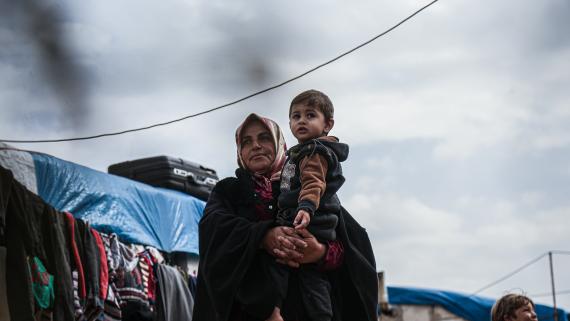
Barisha IDP Camp, Syria
This Syrian widow has been living in Barisha IDP camp for 10 months with her children and two of her grandchildren. The camp was established in 2019 for people with special needs and widows who were displaced from Kafr Nabl. It hosts 410 families, including many with special needs. “The coronavirus has spread around the globe, and we fear it could come to us because of the tight and crowded conditions we live in,” she says. “When my children go out to play, I worry about where they are playing and whether it is safe or dirty. I wash them with soap when they return home.”
Over the past year, an already complex humanitarian access situation has become more challenging; the number of border-crossing points authorized by the UN Security Council for UN-delivered assistance and supplies has been reduced from four (in 2019) to just one.
The combined impact of these changes has been far-reaching, with several factors currently driving needs. Hostility-induced mass displacements have decreased since March 2020, but life-threatening needs remain disproportionately high among displaced communities. More than 1.5 million of the 2.7 million IDPs in NWS currently shelter in around 1,100 “last resort” sites. Many of these sites are overcrowded, and access to shelter, safe water, food, health and psychosocial support is inadequate.
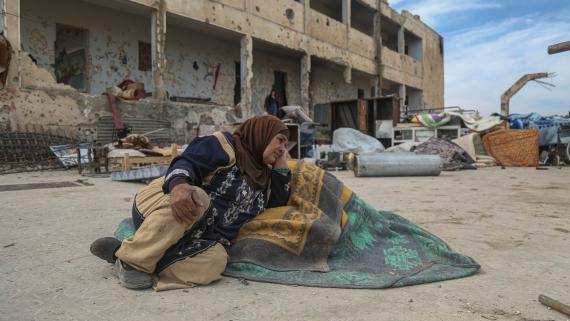
Binish, Syria
Sixteen families originally from Marret Al-Numan, in the countryside south of Idleb, now live in a damaged school in the town of Binish. They were displaced four months ago and have no other option as they could not obtain a tent in the nearby IDP camps.
OCHAAcute needs stemming from a lack of access to basic services, livelihoods and economic opportunities, combined with high levels of destruction to critical civilian infrastructure, including health facilities, water systems and schools, are also observed in parts of Deir-ez-Zor, Al-Hasakeh and Raqqa Governorates in north-east Syria; in Dar’a Governorate in the south; and in overburdened host communities in Damascus and Rural Damascus.
Across Syria, the dramatic socioeconomic decline has reduced purchasing power and the availability of essential goods and services. It has also severely limited employment opportunities, adding to growing poverty. The average food basket in Syria cost 247 per cent more in October 2020 than at the same time in 2019. These trends have resulted in a sharp increase in food insecurity – from 7.9 million people a year ago to 9.3 million by July 2020.
Syria: psychosocial support to displaced families
“Each day I wake up in the hope of bringing about change. A change in the life of someone in need.” The psychosocial camp counsellor for Atma IDP camp, herself displaced since 2012, visits displaced families every day to talk about their stresses and offer support to children who have lost their parents. She offers a small amount of comfort and relief in the midst of a war that has had devastating impacts on her community.
OCHAAdditional ‘silent’ consequences of years of crisis include unprecedented levels of stunting affecting 674,000 children under 5 years of age (a 37 per cent increase compared to 2019); increased morbidity related to non-communicable diseases; gender-based violence (GBV); and widespread psychological trauma, especially in children. More families are being forced to make unacceptable trade-offs to survive, including skipping meals, taking on additional debt, and pre-emptively moving to areas where humanitarian assistance is assured, such as camps.
The widespread lack of livelihoods and employment opportunities, inadequate access to basic services and growing food insecurity have become principal drivers of need, denying millions of people the ability to meet their basic needs in a dignified, self-sustained manner.
Projected situation in 2021 and beyond
These trends are expected to continue into 2021, leading to an increase in PiN from 11.1 million to an estimated 13 million in 2021. The scale of needs stemming from new or recurrent displacements will depend on a potential increase in hostilities in NWS, as well as other locations. Syria remains a ‘protection crisis,’ with related needs resulting from hostilities, widespread explosive hazard contamination, psychological trauma, GBV and family separation, among others.
Returns are expected to continue in line with trends in 2020. Even if a COVID-19 vaccine becomes available, the virus is expected to spread further. It will spare few people, but most acutely affect people living in densely populated areas and/or areas where basic service provision is weak.
Evolution of needs and requirements (2016 - 2021)
Response priorities in 2021
Consequently, humanitarian actors will focus their multisectoral response efforts on the following priorities in 2021:
-
Respond to critical protection risks, ensuring protection risk assessments inform all humanitarian programming.
-
Maintain critical basic services, including through the rehabilitation of key civilian infrastructure, with a focus on mitigating the impact of COVID-19 on people’s health and its secondary effects on livelihoods, education and protection needs.
-
Scale up livelihood and agricultural support to respond to growing food insecurity.
-
Improve chronic malnutrition among under-fives and nutritional deficiencies in pregnant and lactating women through coordinated nutrition, food security, health and WASH interventions.
-
Address basic needs of the most vulnerable IDP, host community and returnee households as flexibly as possible, including addressing assistance gaps in last-resort IDP sites, with a particular focus on winterization support.
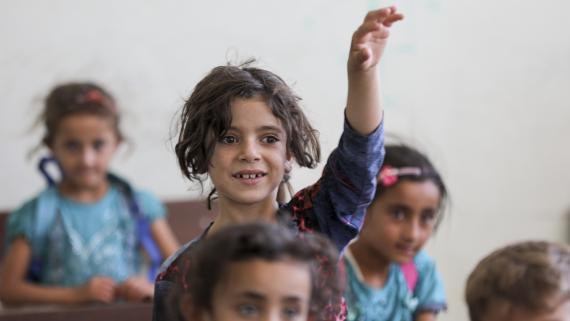
Idlib, Syria
Syrian children have experienced years of war full of violence and multiple displacements. Ahead of them is an uncertain future and fear of new struggles. The new school year for 4 million girls and boys began in Syria in September, but around 2 million children do not go to school. Many school buildings were destroyed, are being used as emergency accommodation, or urgently need repair. Thousands of teaching positions could not be filled.
UNICEF/Khalil AshawiTo access people in need, humanitarian responders will continue to leverage and advocate for all cross-border and cross-line response modalities. The UN estimates that 10.5 million people will be targeted with humanitarian assistance in 2021. This is an increase from 9.5 million people at a cost of $4.2 billion, which is a 10 per cent increase compared to 2020.
Further reading
Source: Humanitarian Insight
Source: Financial Tracking Service
Source: OCHA
Source: OCHA
Yemen
Analysis of the context, crisis and needs
Humanitarian needs continued to grow in 2020, driven by the escalating conflict and a protracted economic blockade that has fuelled the ongoing economic crisis. The situation was exacerbated by torrential rains, a fuel crisis, the threat of desert locusts and COVID-19. The operating environment continues to be extremely restricted, hindering a principled aid operation, and the humanitarian response was crippled by a huge funding shortfall. Capacity within the humanitarian operation was a further limitation. By mid-2020, Yemen had returned to alarming levels of food insecurity and acute malnutrition. All indications suggest that the severity of needs for large sections of the population is increasing. COVID-19 has compounded food insecurity, mainly due to limited work opportunities, lower incomes and reduced remittances.
Conflict intensified during 2020, resulting in shocking levels of civilian suffering. By the end of October, there were 47 front lines, up from 33 in January 2020. The war had already caused an estimated 233,000 deaths, including 131,000 from indirect causes such as lack of food, health services and infrastructure. Hostilities have directly caused tens of thousands of civilian casualties; 3,153 child deaths and 5,660 children were verified in the first five years of the conflict, and 1,500 civilian casualties were reported in the first nine months of 2020. Attacks continue on facilities protected by international humanitarian law, including medical centers.
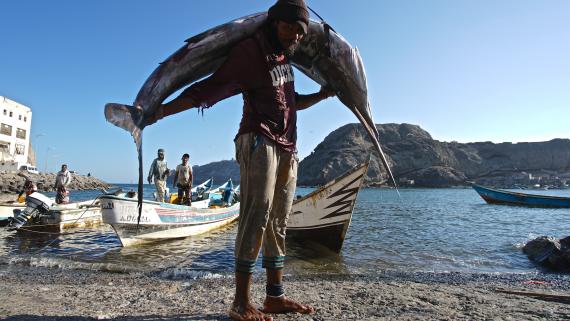
Crater, Yemen
A fisherman carries a freshly caught swordfish ashore to sell at the Siera fish market in Crater, Aden. Since the war intensified in and around the key port of Al Hudaydah, competition and boat traffic has increased exponentially as more boats and crews head south to calmer waters and more stable markets.
OCHA/Giles ClarkeYemen’s economy was subject to further shocks this year and macroeconomic stability remained absent. By the end of September, the Yemeni rial had depreciated to an all-time low of YER850 (US$3.4) in southern governorates. Foreign reserves dried up, and remittances from Yemenis abroad, the largest source of foreign exchange, fell by up to 70 per cent due to the COVID-19 global downturn. With nearly all goods imported, more people are being squeezed out of markets, unable to afford essential items. Fuel shortages in northern governorates from June onwards exacerbated the humanitarian situation, reducing essential services and the transport of essential goods, constraining access to income opportunities and restricting the humanitarian operation.
Between April and August 2020, heavy rains and flooding devastated communities, causing deaths and injuries, destroying infrastructure and livelihoods, and increasing the spread of deadly diseases. Tens of thousands of families were affected, many of them already displaced. Other natural hazards pose a threat, including desert locust infestations, which are expected to cause damage and loss worth $222 million to staple crops, animals and livestock.
Despite some advances made with authorities in overcoming bureaucratic constraints, the operating environment shrank further in 2020. Since August 2020, some 19.1 million people in need were in hard-to-reach areas, where armed conflict and insecurity, bureaucratic constraints and logistic impediments often combined to challenge aid deliveries. By October, most COVID-19-related restrictions had been lifted, but pre-existing challenges around movement restrictions and interference in humanitarian activities still hamper the response. Humanitarian staff continue to be detained, harassed and threatened and their visas arbitrarily refused or withdrawn.
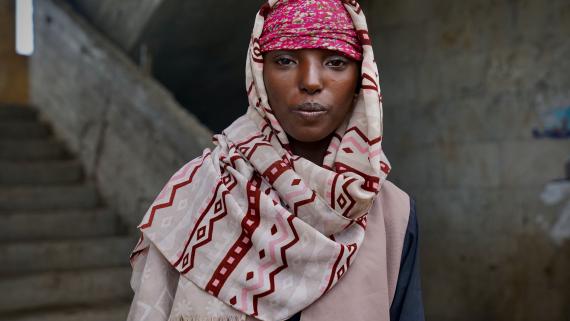
Aden, Yemen
This 12-year-old girl fled the port city of Al Huydaydah with her family. She now lives at a former school on the outskirts of Aden. She has three brothers and four sisters and dreams of being a teacher.
OCHA/Giles Clarke
With only 50 per cent received of the $3.386 billion needed to fund the response, drastic cuts have been made to the aid operation, and 31 out of 41 critical UN programmes have been reduced or closed. Aid agencies are now reaching about 10.7 million people a month, down from over 13.6 million people a month at the start of the year.
More than 3.6 million civilians have been displaced due to the conflict, including at least 158,000 in 2020. Some of the highest levels of vulnerability are concentrated in IDP sites where very few services are available. An estimated 422,000 migrants, asylum seekers and refugees in Yemen are at extreme risk and an estimated 138,000 are completely reliant on aid. COVID-19 resulted in a backlash against this group, many of whom have been forcibly moved, detained and subjected to inhumane conditions. Thousands remain stranded in dire need of assistance.
Evolution of needs and requirements (2016 - 2021)
Humanitarians continue to work towards delivering an efficient, effective and principled response, but the outlook remains bleak. The latest (partial) IPC analyses show that by December 2020, the population facing high levels of acute food insecurity (IPC Phase 3 and above) will increase from 2 million to 3.2 million people (40 per cent of the 7.9 million population analysed in the south). In December 2018, a quarter of a million people were found to have slipped into severe food crisis, with the worst hunger clustered in conflict-affected areas.
Acute malnutrition among children under 5 years of age has hit record levels in some areas. Over half a million children under 5 years of age face acute malnutrition, up 9.5 per cent. Severe acute malnutrition is up by 15.5 per cent this year, leaving 100,000 young children at risk of dying without treatment. There are acute WASH deficits in 54 districts, and 46 districts are at high risk of cholera. COVID-19 is an added burden on the fragile health system, where only 50 per cent of facilities are functional. This has discouraged the population from seeking treatment for other deadly diseases and conditions.
Projected situation in 2021 and beyond
In 2021 the situation is expected to deteriorate further, and the severity of needs is expected to increase unless there is conflict de-escalation and an improvement in the economy and funding.
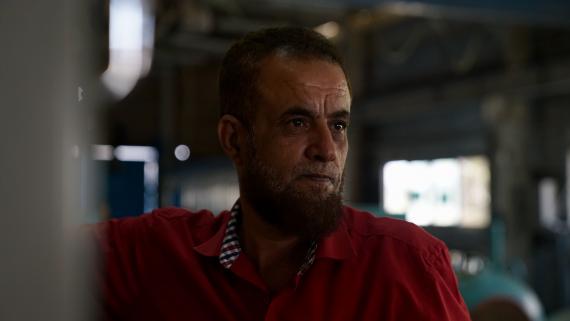
Ma’alla, Yemen
This Yemeni man is the head of the al-Barzaq water pumping station, where he has worked for 32 years. During the battle for Aden in 2015, every day he visited the pumping station, which was across an active frontline from his home, to ensure water reached the city’s population. He said: “I remembered that there were many families in Ma’alla who need this water, and this was the drive that made me come every day and risk my life to get here.” He also said the city desperately needs better water infrastructure and new pipes, for which the local government is unable to provide funding.
OCHA/Giles ClarkeResponse priorities in 2021
During 2021, more than 105 partners across Yemen plan to assist 19 million people. The response will prioritize: fighting hunger by providing food assistance and supporting livelihoods; reducing outbreaks of cholera and infectious diseases; providing basic services to displaced families living in emergency and IDP settlements; protecting civilians and advocating for adherence to international humanitarian law; and rehabilitating public infrastructure to enable life-saving basic services to the population.
Further reading
Source: Humanitarian Insight
Source: OCHA
Source: Financial Tracking Service
References
- Palestinian Central Burau of Statistics (PCBS), Labour Force Survey, April-June 2020.
- See, Report by the High Commissioner of Human Rights, Ensuring accountability in the occupied Palestinian territory, March 2020.
- The World Bank, Economic report to the ad-hoc liaison committee, June 2020.
- Figures for People in need, People targeted and Requirements are pending the finalization of the 2021 HNO and HRP.
- Figures for People in need, People targeted and Requirements are pending the finalization of the 2021 HNO and HRP.

